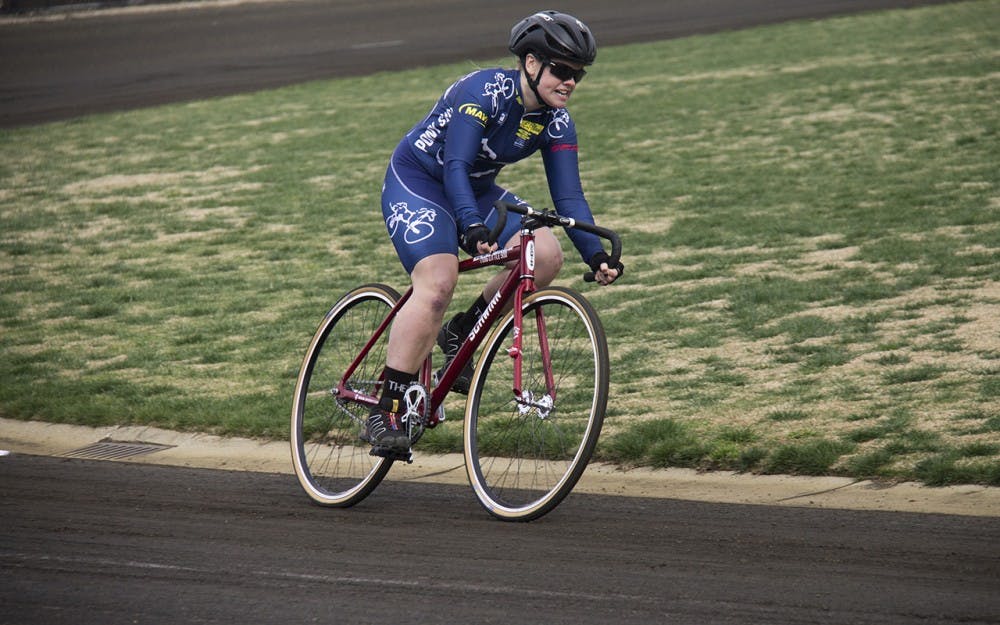Everyone knows about qualifications and the Little 500 race, but the events between the two can often go overlooked.
With individual time trials slated for Wednesday, it’s time to get to know what they’re all about.
ITTs are part of a group of three events between qualifications and the Little 500 race known as the spring series. The events have no real effect on the race, but they do have some predictive trends.
The top five women’s teams in last year’s spring series all finished in the top five in the Little 500 race.
In addition to being a good forecast for a team’s race prospects, spring series helps riders fulfill some necessary requirements.
To be eligible to participate in the Little 500 race, riders must compete in at least two spring series events, with ITTs scheduled as the first of the three. The other two events, Miss N Out and team pursuit, will take place April 1 and April 9, respectively.
There are a total of 95 heats in this year’s ITTs, with four riders in each heat. The heats are scheduled so they alternate between men and women. The first heat starts at 3 p.m., and the last heat is scheduled for 11:10 p.m. If spectators can only go for part of the time, Little 500 Race Director Andrea Balzano recommends going to the latter half.
“Between 8:45 and 10, we have our fastest heats,” Balzano said. “At 8:55, we have our fastest men’s heat. At 9, we have our fastest women’s heats. We call that our power hour.”
ITTs are different from other Little 500 events in that they are the only event that is individual-oriented. The four riders in each heat begin in a separate corner of the track. They are not allowed to be sitting on the bike before the gun sounds. When the gun goes off, the clock begins, and each rider completes four laps around the track and finishes in the corner where he or she began.
After the riders finish their fourth lap, the clock stops, and the riders are given their times. These times are then ranked from lowest to highest.
With last year’s champion, Tabitha Sherwood of Phoenix, having graduated, there is no chance for a repeat winner this year. It’s reasonable to suspect the fastest time to come from the women’s heat slated for 9 p.m. The four women in the heat finished from second to fifth in last year’s ITTs.
Kristen Bignal, a senior on Delta Gamma, finished second last year with a time of 2:36.98. Bignal said she believes the key to succeeding in ITTs is mental perseverance.
“It’s a big mental barrier you have to get past because surely everyone’s legs are going to be dead,” Bignal said. “Your body is going to be saying, ‘I’m hurting. Slow down. Stop.’ You just have to persevere mentally and fight through that pain.”
Bignal’s heat is composed entirely of seniors, and joining her will be Grace Bennett of Kappa Alpha Theta, Leigh Dukeman of Alpha Omicron Pi and Megan Huibregtse of the Ski Club, who finished third, fourth and fifth last year, respectively.
Although Bignal said she knows she’ll be going up against some tough competition, she said it won’t affect the way she approaches the event. When she rides in ITTs, she said she focuses on herself and doesn’t worry about the other riders on the track.
“During ITTs, I usually block out everything, like the fans, other people riding,” Bignal said. “It’s just me in the zone. I think if you do pick your head up and look, it distracts you and slows you down a little bit.”
This year will be Bignal’s last shot to win ITTs. She acknowledged that fact and said she uses it as motivation to win ITTs.
“I think it’s a very possible goal after last year,” Bignal said. “After last year, I know I have the ability to win this year. I know I can do it. It’s just a matter of if I can execute.”
Even if she doesn’t finish first in her heat, Bignal said she’d still feel happy for whoever does.
“I’d be a little upset because I’d like to do well, but it’s definitely friendly competition,” Bignal said. “We all support each other.”






